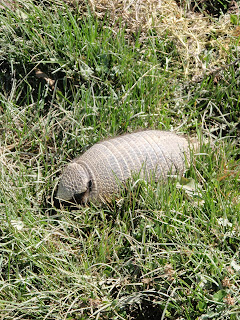Buenas Dias!
Nathan and I have been visiting a lot of
glaciers lately in
Parque Nacional de Los Glaciares, or Glaciers National Park, and Ms. Beth is in heaven! Glaciers are one of my favorite landforms and they are so interesting and beautiful. A
glacier (spelled
glaciar en espanol) is a very large mass of ice that can actually flow and move much like a river. They move VERY slowly though so you can´t actually see them move.
Here in the
South Patagonian Ice Field we have been able to see lots of glaciers. We spent four days backpacking in the park and hiked to see many glaciers. This first picture is of the
Glaciar Torre, and the second is the
Glaciar Piedras Blancas.


Do you notice the brown lines running through the sides and middle of the glaciers? As the glacier moves, it breaks up and pulverizes the rock it moves over and this
sediment gets mixed into the ice. Also, you might notice that in each picture, at the bottom of the glaciers, you see water. These are the
glacial lakes that form as the ice melts in the warmer months. This melted water fills the valleys that the glaciers have carved out and forms
lagos, or lakes.
This next glacier is one of the most famous in the world because it is one of the few
advancing ice sheets, which means it is actually growing and moving forward. It is called the
Perito Moreno and thousands of people visit it every year. While we stood in front of the glacier we could see huge pieces of ice
calve off the front and fall into the lake below. First you hear a really loud
craaaaack and when the piece falls it makes a huge splash and lots of waves! So cool!!

In a few days we will visit another park in Chile where we hope to see lots more glaciers and beautiful mountains too!





 Another animal we saw in the park was the
Another animal we saw in the park was the 




 When I went for a bike ride near Bariloche I saw this lovely flower, called the Amancay. It is one of the national flowers of Argentina and many artists here create paintings, photographs, wood carvings and even jewelry inspired by this flower.
When I went for a bike ride near Bariloche I saw this lovely flower, called the Amancay. It is one of the national flowers of Argentina and many artists here create paintings, photographs, wood carvings and even jewelry inspired by this flower. 
 One of the other students in my class was a woman named Laurie, and she and her family are going to be living in Argentina for several months while her husband, Tim, works in Buenos Aires. They are all from Cleveland, OH. Laurie's kids, Madeleine and Liam, are 11 and 8 years old--the same age as some of you! Can you imagine living in Argentina? I thought it would be fun to find out what it's like for them living in another country so far from home.
One of the other students in my class was a woman named Laurie, and she and her family are going to be living in Argentina for several months while her husband, Tim, works in Buenos Aires. They are all from Cleveland, OH. Laurie's kids, Madeleine and Liam, are 11 and 8 years old--the same age as some of you! Can you imagine living in Argentina? I thought it would be fun to find out what it's like for them living in another country so far from home. I asked them what kinds of foods they eat here in Argentina, and Madeleine said, "Steak!" That's not surprising, because Argentina is one of the largest producers of beef in the world, and everyone eats a whole lot of
I asked them what kinds of foods they eat here in Argentina, and Madeleine said, "Steak!" That's not surprising, because Argentina is one of the largest producers of beef in the world, and everyone eats a whole lot of  After a big dinner of
After a big dinner of